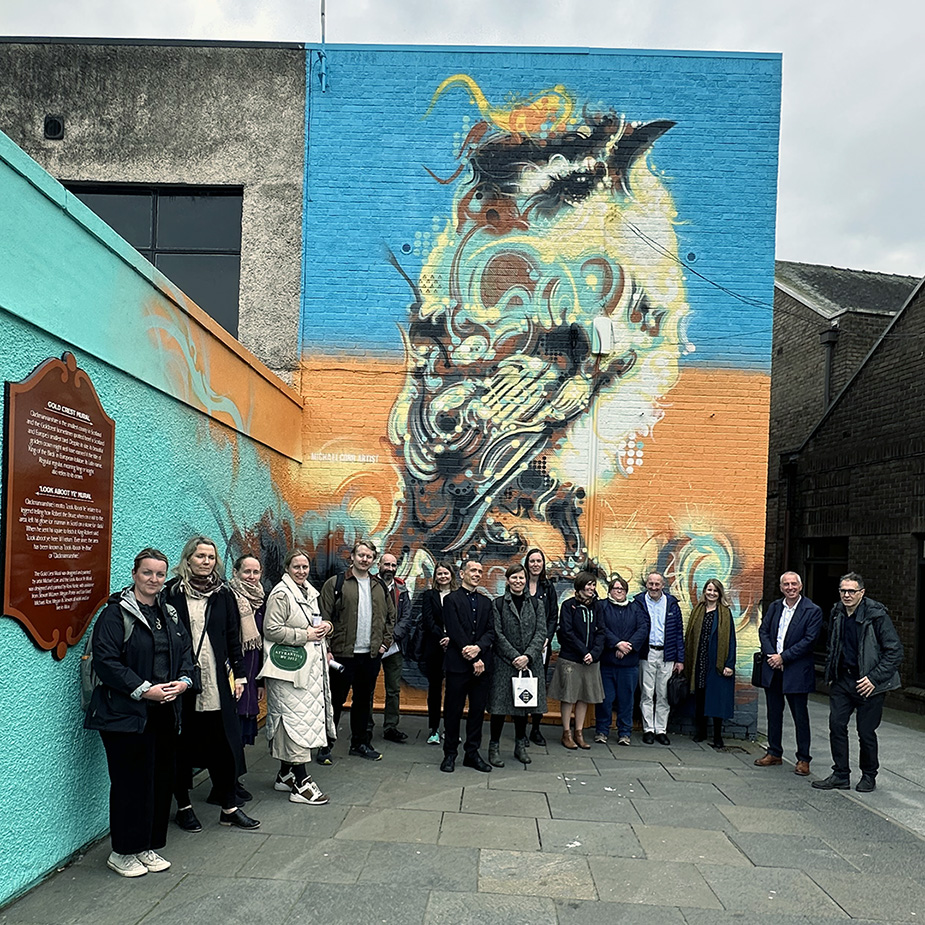In May 2023, colleagues from the City of Stavanger in Norway, visited Alloa, Clackmannanshire to gain insights around use of the Place Standard Tool in Scotland. The visit built on recent successful application of the Place Standard Tool in Kvernevik, a community just outside of the City of Stavanger.
The visit was planned with the support of a range of colleagues from Public Health Scotland, Scottish Government, Glasgow City Council, Architecture and Design Scotland, Clackmannanshire Council, Clackmannanshire Third Sector Interface, Alloa First, Shaping Places for Wellbeing, Bracewell Stirling, Kingdom Housing Association.
Norwegian delegate Christel Dahl, Public health advisor for Stavanger Municipality and Claire Finlayson, Health Improvement Manager, Localised Working Programme, Public Health Scotland share their thoughts on what the visit meant to them.
Using the Place Standard Tool in Norway by Christel Dahl
I was introduced to the Place Standard Tool through a research project. The aim of the project was to conceptualise “social sustainability” and give political and administrative decision makers a greater understanding of the scope and drivers of the three main categories of the UN sustainability criteria - namely environment, economic and social dimensions.
As part of the project, Place Standard Tool was used as a tool to identify and partly measure social sustainability in a somewhat deprived area outside the City of Stavanger. We had great success with the tool. We sent a general Place Standard survey out to 3500 inhabitants in Kvernevik and had a close to 30% response rate. We followed up with focus groups to get a more in-depth understanding of the responses, as qualitative data was provided.
As a project group we were not only delighted by the response and interest the people of Kvernevik showed for the survey, but amazed the amount of information that we gathered in a short amount of time. It is such an easy and effective tool to use, providing great amount of insight to an area from the people themselves.
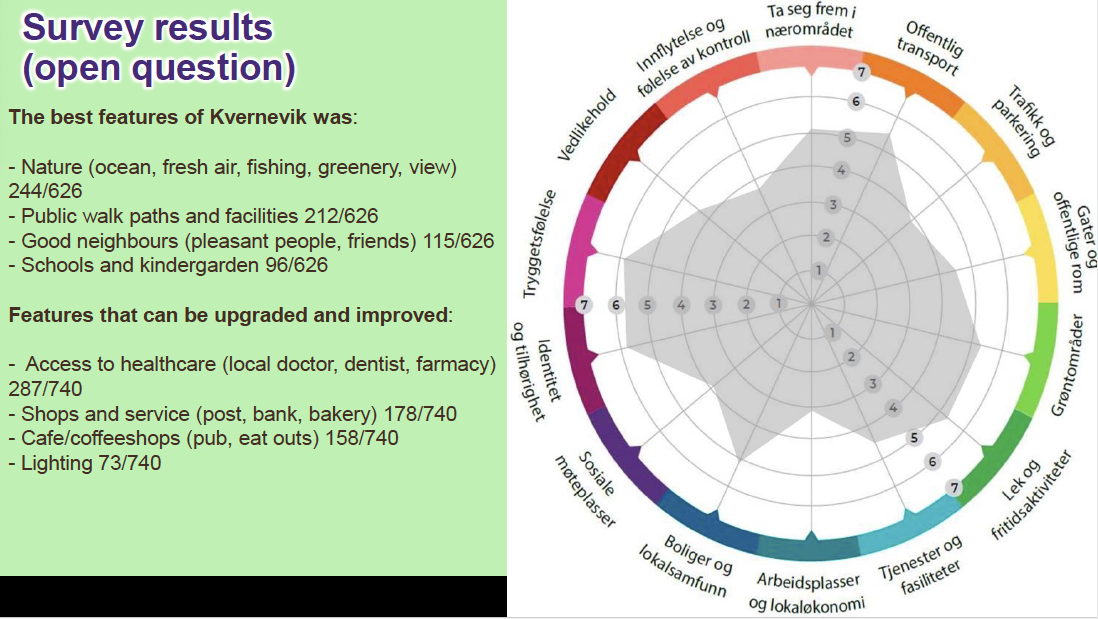
Learning from others
Having such a success with the tool as a project group, we wanted to learn more about the possibilities the tool provided. In what other way has to tool been used? And we asked ourselves if we could, through learning from others who have used the tool, implement the tool in a different way in our work in Stavanger, Norway?
When the possibility of coming to Alloa to see and hear about the work that had been done arose, we could not miss the opportunity. It was important for us as a group to travel all together, as we come with different educational backgrounds and work in different departments as part of the Stavanger city council.
The day in Alloa made such an impression on all of us. First and foremost, the hospitality and the engagement of everyone who participated. We felt honoured that so many nice and dedicated people took the time to share their knowledge and insights through the inspiring presentations. For us it was so useful to hear how the developers of Alloa had invited not only the people of Alloa to participate in filling in the Place Standard Tool, but also engaging stakeholders, important decisionmakers, fellow colleagues amongst others to fill out the survey as well.
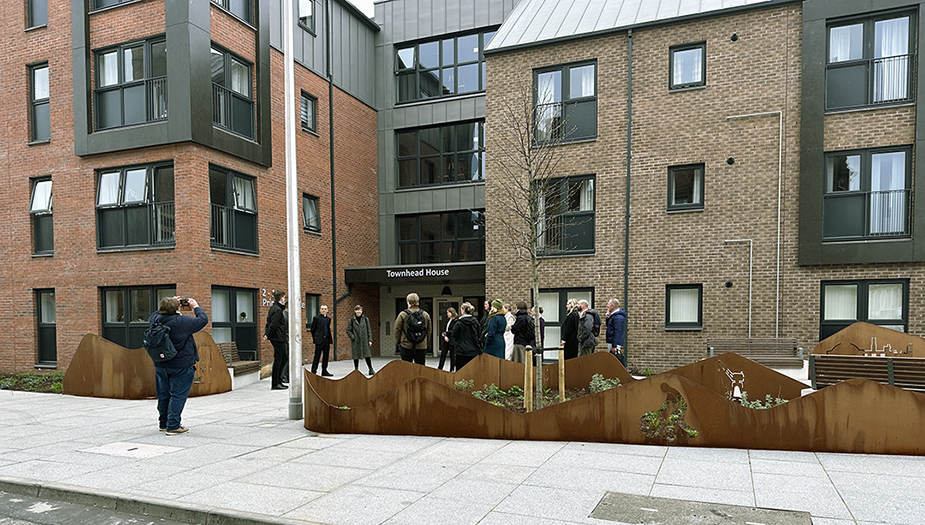
Connections and partnerships
It was inspiring to see how a spark of Place Standard Tool ended in a multi aged housing facility build right in the centre of Alloa. The close connection and partnership between the people of Alloa, decisionmakers of “Clacks”, other stakeholders and the university, impressed us a lot. And it was easy to understand that this partnership was a driving force in action.
We so much enjoyed the walk in Alloa! What a fantastic place. It made such an impact seeing and experiencing Alloa after being introduced to different projects through the presentations. It simultaneously made us aware how having the results from a Place Standard Tool, made it easy to implement quick and visual changes in Alloa.
Witnessing something unique
Finally, one of the biggest impressions we left with, was the sense of pride and ownership everyone who had contributed and invested in Alloa expressed. It made us feel like we had witnessed something unique!
Coming back from our visit, we have already presented our impression, findings and learning in several departments. The trip has given us so many new aspects on how to use the Place Standard Tool. The motivation and eagerness to implement the tool in planning and collecting valuable information is high. And we are all so inspired.
Thank you, Alloa and everyone who made our visit so valuable, memorable and fantastic.
City of Stravanger website
Using the Place Standard Tool in Scotland by Claire Finlayson
The Place Standard Tool was developed through a partnership involving the Scottish Government, NHS Health Scotland (now Public Health Scotland), Architecture & Design Scotland and Glasgow City Council, and implementation of the tool has been supported additionally by the Improvement Service. As a as Health Improvement Manager at Public Health Scotland, my role supports place-based approaches and partnership working to support the use of and learning around the Place Standard Tool.
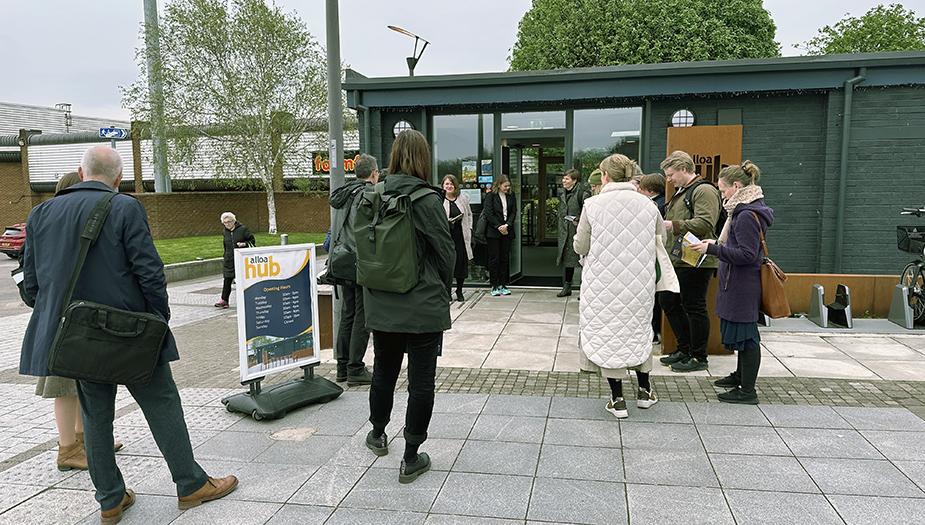
A reinvigorating walk round in Alloa
Our visit to Alloa provided a unique opportunity to hear how the Place Standard Tool has and continues to be used successfully in Clackmannanshire, bringing together strong partnership working and influencing community-led improvements.
We heard from a variety of speakers about an ongoing commitment to embed place-based approaches and implement the tool in a joined-up and meaningful way.
From the onset, partners from Clackmannanshire Council and Architecture and Design Scotland highlighted the influence of the Place Standard Tool in several Town Centre improvements.
Walking around, the centre felt reinvigorated. A former public toilet has been given a new lease of life and is now Alloa Hub, a welcoming and inclusive space in the heart of the community providing health and active travel information. Supporting the identity and meaning of place, the Hub proudly displays the Clackmannanshire Tapestry. Nearby, a key walkway has been transformed into a vibrant display of public art. These targeted and community-led actions for improvement make a big impact and feel transformative.
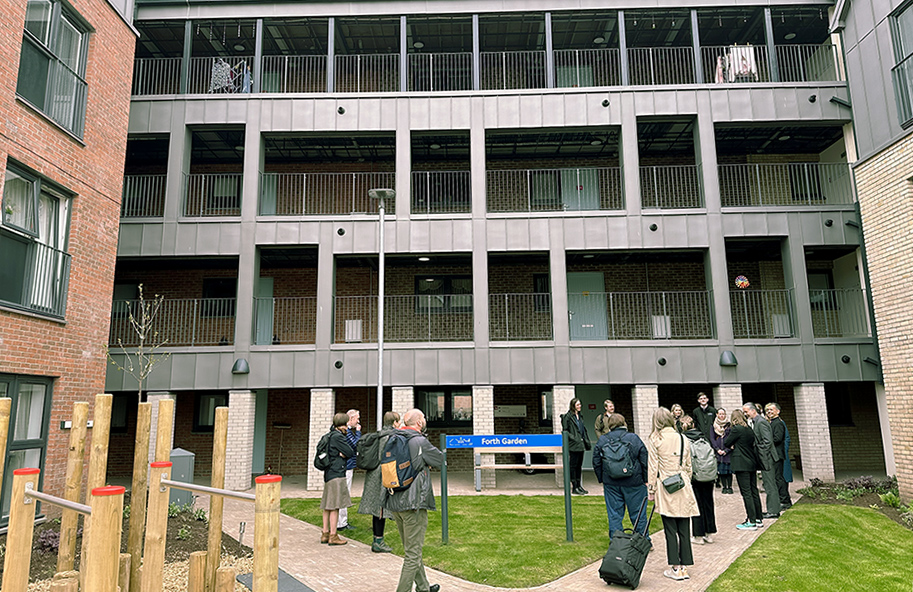
Primrose Street
Town centres and housing are essential building blocks of our communities and have an important influence on our health and wellbeing. The development of Primrose Street has transformed a former derelict site in the heart of the town to an intergenerational living environment.
Place Standard Tool engagement with different professionals successfully informed dementia-friendly design at Primrose Street Housing, as well as wider town centre planning priorities. With continued recognition of addressing the needs of our ageing population, Architecture and Design Scotland later highlighted work around caring places and town centre living, placing user needs at the heart of decision-making, service provision and investment in our places.
Flexibility of the tool and empowerment of the local community
The flexibility of the Place Standard Tool has allowed it to empower the local community in Alloa to positively influence and help shape priorities for improvement. A breadth of community consultation and qualitative analysis has been undertaken by colleagues from Clackmannanshire Third Sector Interface and Alloa First.
The approach in Alloa exemplifies public, business and voluntary sectors working together to deliver high quality, sustainable places. The Place Standard Tool has enabled community engagement in a way that builds ongoing collaboration, sustains relationships and helps a range of partners to understand and take joined-up actions based on the needs of the community.
Identifying priorities and strong partnerships
At a strategic level, our day in Alloa highlighted an ambitious longer-term approach to dealing with the priorities identified through Place Standard Tool engagement. We heard about Clackmannanshire Council’s commitment to empowering people and places to improve their wellbeing, skills and prosperity. Strategies in the area include the establishment of a wellbeing economy and community wealth building.
Taking a strong partnership approach, we heard about the University of Stirling working closely with Clackmannanshire Council to bring innovation and place-based economic transformation to the local community. Established as part of the Stirling and Clackmannanshire City Region Deal, Scotland’s International Environment Centre is driving the creation of a net zero regional economy and acting as a global exemplar of low-carbon growth.
The Place Standard Tool is an evidence-based tool. The Shaping Place for Wellbeing programme is focused on delivering lasting system change and enabling local decision makers to understand the evidence around place-based approaches, building collaborative links and embedding Place and Wellbeing Outcomes.
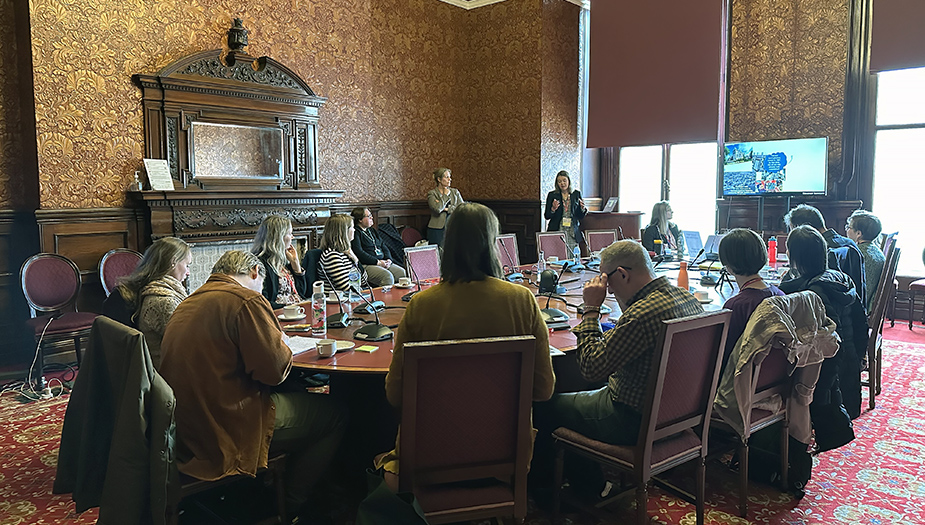
Norwegian colleagues
Since its launch in December 2015, the tool has developed a wide network of use and been recognised, promoted and applied by the World Health Organisation European Healthy Cities Network, UN Habitat and EuroHealthNet.
Hearing from our Norwegian colleagues really highlighted the flexibility of the tool to be used in new settings, building effective communication and collaboration between local communities and organisations.
Colleagues from a variety of roles at Stavanger municipality shared their interest and involvement of using the tool to identify social sustainability and establish it as priority, with the central aim of making the neighbourhood of Kvernevik ‘a better place to be’.
A range of engagement methods successfully undertaken include a text message survey and focus groups with residents, as well as ‘city labs’ involving community representatives and political workshops. Our Norwegian colleague’s enthusiasm for the tool reinforced it as a simple and effective way of structuring conversations around place and identifying priorities for improvement.
Future thinking
The opportunity to come together and share knowledge provided extremely positive insights into the ongoing implementation of the Place Standard Tool. Our shared learning highlighted the importance of ongoing place-based approaches and meaningful community engagement.
When applied effectively, the tool empowers communities and ensures that that priorities of partners across public, business and voluntary sectors are joined-up and informed by local needs.
Going forward, we will continue to support, learn, and feel inspired by collaborative place-based approaches. Partnership working gives us the opportunity to drive forward Place Standard tool engagement, embed place-based working across sectors and shape joined up action based on the needs of local people and communities.
Other views on using the Place Standard Tool
Learn more what others, who where in Alloa with the Norwegian delegates, have said about using the Place Standard Tool, what they learnt from the days together and future thinking.
John Howie, Interim Public Health Principle, Public Health Scotland explains how the Place Standard Tool was introduced to the World Health Organisation in 2016, how it is used internationally, the academic interest and research that has informed local decision making and the further future roll out of the tool internationally.
Learn more about the Place Standard Tool
The Our Place website includes variety of resources, examples and toolbox for using the Place Standard tool to learn more about place. Visit the Our Place website to explore the practical application of the tool.

